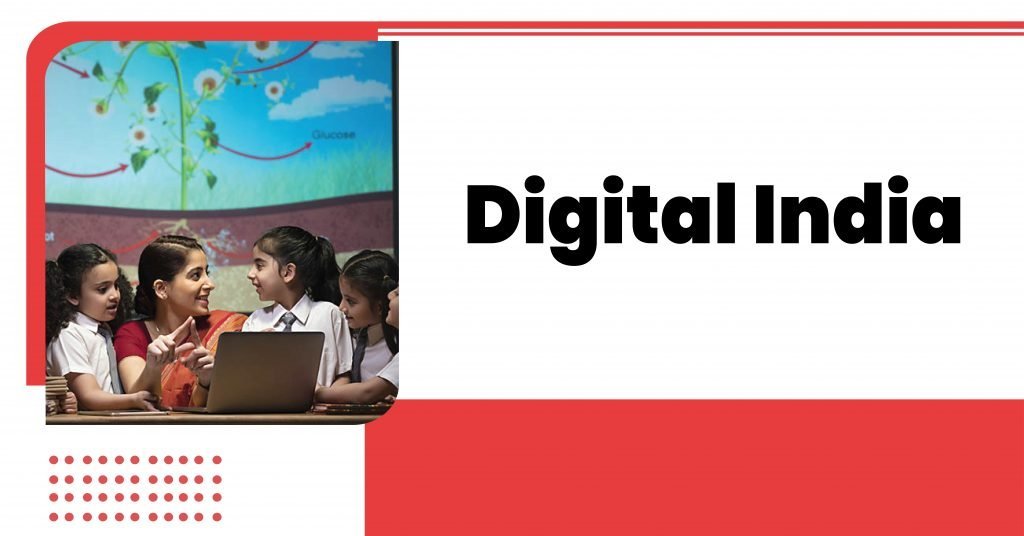Digital India is a program under the Government of India, started in 2015. It is an umbrella program that covers various aspects of the Digital advancement of the country. The program today has grown up to several folds and has made enough impact on the life of Indians and the future of India. On 1st July 2015, our honorable Prime Minister Narendra Modi launched an initiative named Digital India. The primary reason for the launch of this campaign was to make the government initiatives and schemes available digitally so that citizens can apply for the same without a middleman. Thus enhancing transparency and accountability across various sectors. With the motto – “Power to Empower”, this campaign has highlighted the benefits of e-governance and has also equipped the Indians with a digital tool. The sound digital infrastructure created through this campaign will give rise to digital awareness amongst all the countrymen.
“I dream of a Digital India where knowledge is strength – and empowers the People”- Hon’ble PM of India, Narendra Modi. The Government of India launched a massive campaign called Digital India in 2015 to improve the accessibility of government services in various parts of the nation, particularly the remote and rural regions of the country. The campaign also aims to make these services much more comfortable and easier to use for an ordinary man or Aam Aadmi. This initiative helps people increase their access to technology around the country. The goal of Digital India is to transform the country into a digitally empowered society. It guarantees that citizens have electronic access to government services.
On July 1, 2015; Indian Prime Minister Narendra Modi launched Digital India at the Indira Gandhi Indoor Stadium in Delhi, in the presence of major industrialists such as RIL chairman and managing director Mukesh Ambani, Tata Group chairman Cyrus Mistry, Wipro chairman Azim Premji, and others. A conference was held to exchange views regarding digitization and the rise of the internet.
When it comes to the Digital India campaign’s objectives or goals, there are three key components that must be addressed in order to achieve the following goals
A secure, reliable digital infrastructure that connects each part of the country.
E-Governance for providing easy access to various government services.
The population’s digital literacy Inauguration
It was inaugurated as a very resourceful program name Digital India Campaign which was launched on the 1st of July 2015 in the presence of the top industrialist like Tata Group chairman Cyrus Mistry and RIL (Reliance) Chairman and Managing Director Mukesh Ambani, Wipro chairman Azim Premji except at the Indira Gandhi Indoor Stadium, Delhi. A meeting was held where various ideas and words were shared, which were related to the digitalization of the country evoking (call) the internet Revolution among the masses of the country.
In the presence of various IT companies, numerous events were held to wrap 600 districts of the country under this campaign. To digitally grow the country and improve the IT institutions of the country was one of the biggest steps ever taken in this campaign more than 1 lakh crore Rupees are interested to unveil the program by launching various schemes of the digital India campaign such as national scholarship portal, health education, Digital Locker and many government programs became online like Aadhar Card.
The Objective of Digital India
The government of India drives it. Digital India is a campaign launched to empower the country digitally the motive day campaigns to enable strengthen the electronic services of the Government of India it is done by reducing the paperwork. It will be a very fruitful technique as it takes off the weight of investing time over paperwork and devotes man never in various fields of government it is highly efficient and useful for the government officials who work on a large scale. Three significant aspects of digital India campaign are:- Digital infrastructure
- Digitally delivering services
- Digital literacy
- Digital infrastructure refers to create space where all the registered citizens will have a Digital Identity, which will help in getting secure and fast government services. All the government services like managing a bank account, Financial Management, education, and distance learning, etc. which now can be made much easier to use and which will be safer and Secure from cyber-crime. Digitally delivering services required to facilitate all the peoples connect to the system and will get benefits of government plans and policies as soon as they are launched and as when it is needed it will also promote online businesses at it make the financial transaction easy by electrification and cashless transactions. It helps the country in globalization as it connects one individual to the whole country world through their phone or computer screen; it will avoid maintaining documents at paper length as all will be saved and delivered through the internet at all levels like school, college’s, offices, or any other Institute or Office.
- Configuring a program to facilitate both the customer and the service providers. This project is targeted to be ended by 2019 and it succeeds as it made a lot of changes in the lifestyle of people as they started using mobile, internet, started doing online payments, etc..This project especially focuses on making a road between the government and the public of the country, which will completely free from any difficulty to travel hair government services, will reach the doorstep of the public just by a click.
Advantages of digital India
- It makes health service and literacy more reachable as one can utilize a hospital service, to get online registration, and appointment with the doctor payment of the fee diagnosis test online blood check, etc.
- It makes it possible for people to submit their documents and certificates online anywhere, which reduces physical work.
- To sign the framework, citizens may digitally sign their records online.
- It provides benefits to the beneficiaries to the National scholarship portal by allowing submission of application verification process sanction and then payment or disbursal.
- It is a big platform that facilitates the efficient delivery of government or private services all over the country to its citizens.
- There is a plan of outsourcing policy also to help in the digital India initiative.
- For better management of online services on mobile such as voice data multimedia etc. BSNL’s next-generation network will replace 30 years old telephone exchange.
- National Centre for flexible electronics will help in the promotion of flexible electronics.
- Deployment of Wi-Fi hotspots has been planned by the BSNL all across the country in both urban and rural areas.
- There is a Broadband highway to handle all the connectivity related issues.
- Open access of broadband highways in all the cities, towns, and villages will make possible the availability of world-class service on the click of a mouse.
- It helps the country to grow fast as it provides internet to rural areas which help in connecting them to cities and all the work will be faster.
- It helps in the reduction of corruption. As all of the work will be done with mobile by own, then there will be no corruption.
- Also helps in the decrease of Black Marketing as all the transaction will be done through the digital process.
Disadvantages of Digital India
- Many poor people do not have bank accounts. Although the Jan Dhan Scheme launched by the government succeeded in bringing millions into the banking system, the process is not complete and many of the accounts are non-functional. The government has to rectify this problem and bring the entire poor and marginalized section into the banking system.
- The small retailers in India deal only in cash and have not been able to invest in the digital infrastructure.
- The taxes, surcharges and the fees charged on digital transactions need to be made liberal in order to encourage the people to adopt the practice. Otherwise the public would not be willing to move towards a cashless society.
- Hacking and cyber theft are grave dangers that plague the digital world. Hackers can steal information and money from anywhere in the world. The challenge before the government is to put strong security systems in place to protect the online transactions from the hackers. Researchers have shown that it is easy to crack the PIN number and gain access to the virtual wallet by using software, if the cyber criminal gets possession of the victim’s phone.
- The Indian public is not much educated with regards to the benefits of using cards or online payment methods. A vast majority prefer using cash as a convenient method of payment. Even the card holders consider cash to be a quick method and easy method.
- India is more prone to cybercrime as no rigid measures are available for cyber security in India.
- Issue of last mile connectivity – India has thousands of villages with no active electric supply – digitalizing them is difficult.
- The Digital India plan comes at a time when the debate of net neutrality has still not been resolved. Net neutrality is important for entrepreneurs, who play a major role in this whole campaign. Hence, it is of the utmost importance that the debate be resolved at the earliest.
- People’s mindsets are still pre-digital, as is the functioning of government’s public interface.
- The server is down in pre-digital and post-digital India.
- Low internet speed with high prices – for the success of digital India, broadband connection is a must. Surely it would not work on 2G. Prices of 3G and 4G are so high that everyone can’t afford it.
- Many small and medium scale industries have to grapple a lot to take up the new modern technology.
- The internet speed, which comes daily, including the Wi-Fi hotspots, doesn’t work fast in regards to other developed nations.
- The restricted capability of entry-level smart phones for flexible internet access in the country.
- Shortage of skilled workforce in areas such as digital technology creates an issue for all.
The digital India program has impacted the development of our nation hugely. The impacts can be counted as Economic, Environmental or social. It is estimated that a campaign like digital India can uplift the economy of India by one trillion and now the government is working towards transforming it into a five trillion economy. The digital Literacy of India has increased too. It has made us all survive times like a pandemic. According to a report by Nascom and Akamai, Indian internet users were likely to hit 730 million by 2020 which is more than double the users that were five years before. There were around 330 million users in 2015. The usage of the internet has increased up to 50%. Today, there are more than 100 crore mobile users in the country. With the usage of Digital platforms, corruption is highly reduced.
Each action of humans greatly impacts the environment we live in. The technology of Digital India reduces the footprints humans have on the environment. The reduction of paper consumption is among the many benefits that can be attributed to the use of digital platforms. In addition to this, these digital platforms reduce travel and pollution. But like everything is not perfect, there are loopholes in the digital platforms as well. There is still some advancement that needs to be done and some threats that need to be tackled with the foremost attention. Like the threat of Cyberattacks. With all the digital platforms, the major concern, at stake, is the privacy of people and cyber security while using the internet.

Mrs. Sarita Almeida
B.A.|| B.Ed
School Principal at Rahul Education, Mother Mary’s English High School


